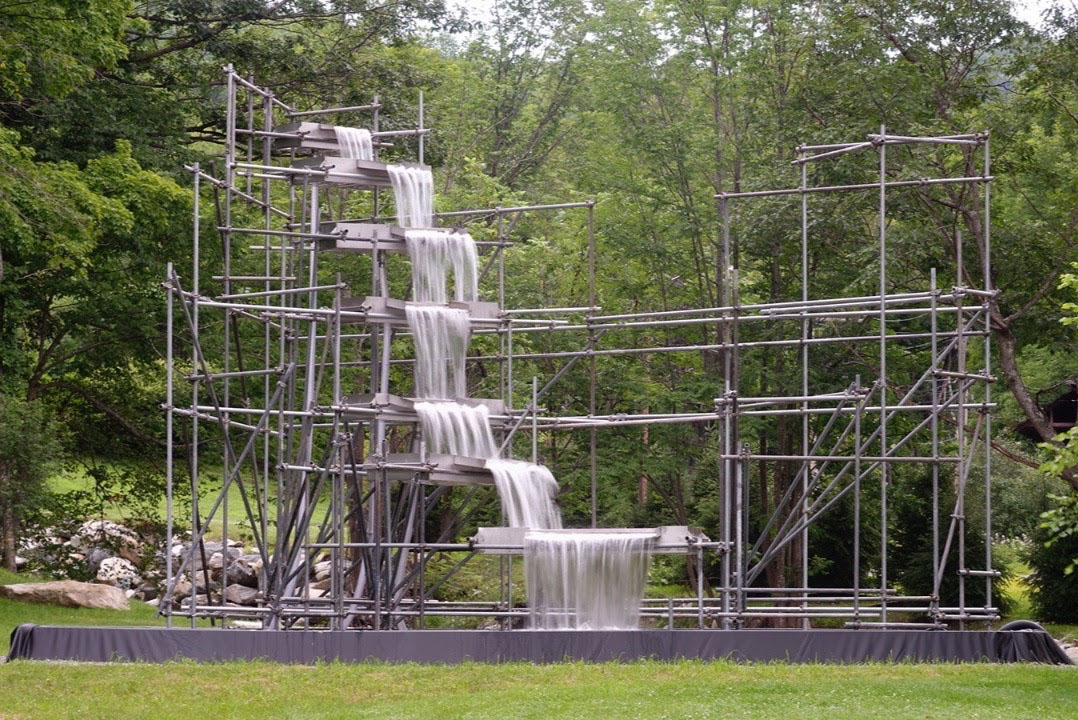Saturday, May 13—READING—The Hall Art Foundation in Reading is gearing up to reopen for the season on May 13 with three new shows. The exhibition lineup is as follows:
1) Andy Warhol: small is beautiful
A comprehensive and intimate retrospective of the paintings of Andy Warhol, including over 100 small format paintings from the Hall Collection that span Andy Warhol’s entire career with important examples from his most seminal series.
Cultural icon, celebrity and provocateur, Andy Warhol produced works that are instantly recognizable and have inspired a generation of artists. Seriality and appropriation were signature aspects of Warhol’s painting and sculptural practice. He often made many different versions of the same subject, perhaps most famously with his iconic multi-part work, Campbell’s Soup Cans (1962) which depicts 32 different versions of a Campbell’s soup can. Shortly after completing these works, Warhol began to make paintings using silk-screens, a process that greatly facilitated his explorations of image multiplicity. For any given subject, Warhol might use several different source images, producing multiple versions of each picture, sometimes in different sized formats, or sometimes using different color combinations for the silkscreen inks and paints, or sometimes both. In other cases, he would use the same exact silkscreen and the same color silkscreen inks and paints, allowing the randomness of the screening process itself to introduce variations in tonality and color saturation in the individual paintings.
Warhol was a painter, photographer, draftsman, sculptor, filmmaker, collector and diarist, but this show focuses on just his paintings. And while Warhol made many large-scale paintings, this is an exhibition of some 100 smaller format, domestically scaled works, all from the Hall Collection, that span his entire career as a fine artist, with important examples from his most seminal series, and which provide a more intimate look at Warhol.
The largest work presented here is Twenty Fuscia Maos (1979), which measures 39 x 38 inches and portrays an iconic reversal (or negative) image of Chairman Mao Zedong repeated 20 times. The smallest work is Roy Lichtenstein (1967), a portrait of Warhol’s Pop Art contemporary which measures just 5 ½ x 4 inches.
Altogether, the 100 works presented in “Small is Beautiful” provide a comprehensive retrospective of the paintings of Andy Warhol, but in small scale.
2) Susan Rothenberg
This exhibit includes nearly 30 paintings that trace the evolution of the internationally acclaimed American artist Susan Rothenberg’s figurative, emotionally-charged and gestural style from her iconic horse paintings of the 1970s to works completed in the past decade.
Throughout the past fifty years, the internationally acclaimed American artist Susan Rothenberg (1945-2020) was an independent figure who continued to challenge and extend painterly conventions, meshing abstraction with representation and confounding figure and ground.
This show will include nearly 30 paintings that trace the evolution of Rothenberg’s figurative, emotionally charged and gestural style from her iconic horse paintings of the 1970s to works completed in the past decade.
3) Ron Gorchov
Spanning nearly 50 years of his work, this survey includes approximately 20 paintings from Gorchov’s first shaped canvases made in the early 1970s to large scale works created in the last years of his life.
Spanning nearly 50 years of his work, this survey includes approximately 20 paintings from Ron Gorchov’s first shaped canvases made in the early 1970s to large scale works created in the last years of his life.
Gorchov emerged in the 1960s as part of a group of Manhattan-based abstract artists, such as Frank Stella, Richard Tuttle, Blinky Palermo and Ellsworth Kelly, who rejected the traditional format of a rectangular canvas in favor of new shapes and configurations. Noticing that “…paint looked better on curved surfaces”, Gorchov began to experiment with the shape of his canvas. After teaching himself how to work with wood, he created his first curved surface painting in 1967. Made by stretching canvas or linen across a bespoke curved wooden frame, Gorchov’s unconventionally shaped canvases bend both inwards and outwards and are simultaneously concave and convex. Described as saddles, masks or shields, Gorchov’s works blur the boundary between painting and sculpture.
Visiting Hall Art Foundation
Converted from a former dairy farm, the Hall Art Foundation’s campus of converted galleries make up approximately 6,000 square feet of exhibition space. The buildings abut a tributary of the Black River and are surrounded by approximately 400 acres of pastures, hayfields and woodland.
Outdoor sculptures by world-renowned artists such as Olafur Eliasson, Antony Gormley, Richard Long and Marc Quinn are installed throughout the grounds.
Hall Art Foundation is open seasonally, on weekends May 13-Nov. 26.
Self-guided visits are available Saturdays and Sundays with entry times at 11 a.m., 12 p.m., 1 p.m., 2 p.m., 3 p.m. Closed at 4 p.m. Advance reservations recommended, but not required. Entry cost for adults is $15; kids 12 and under are $5. (Reading residents receive 50% off.)
Tours are also offered Saturdays and Sundays at 10 a.m. and last 1 hour. There is limited capacity, so advance reservations are recommended. Tour cost is $18. (Reading residents receive 50% off.)
Hall Art Foundation is located at 544 VT Route 106 in Reading. For more information visit: HallArtFoundation.org.




